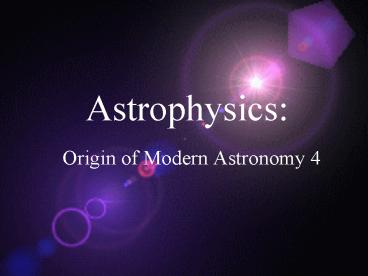Astrophysics: Origin of Modern Astronomy 4 - PowerPoint PPT Presentation
1 / 27
Title:
Astrophysics: Origin of Modern Astronomy 4
Description:
Mike's car, which weighs 1,000 kg, is out of gas. Mike is trying to push the car to a gas station, and he makes the car go 0.05 ... – PowerPoint PPT presentation
Number of Views:76
Avg rating:3.0/5.0
Title: Astrophysics: Origin of Modern Astronomy 4
1
Astrophysics Origin of Modern Astronomy 4
2
Newtons Force
- Force
3
Types of Forces
- Frictional force
- Normal force
- Applied Force
- Air Resistance Force
- Tension Force
- Spring Force
- Gravitational Force
- acceleration due to gravity on Earth
- g 9.8 m/s2
4
Force Diagram
FN
Fgrav
5
Balanced vs. Unbalanced Forces
6
Newtons Three Laws
- First Law (Law of Inertia)
7
(No Transcript)
8
FORCE IS NOT NEEDED TO KEEP AN OBJECT IN MOTION!!!
9
Newtons Second Law
- Fma
10
This is an example of how Newton's Second Law
works
50 newtons
Mike's car, which weighs 1,000 kg, is out of gas.
Mike is trying to push the car to a gas station,
and he makes the car go 0.05 m/s/s. Using
Newton's Second Law, you can compute how much
force Mike is applying to the car.
11
Newtons Second Law
Fma
- Force does not cause MOTIONit causes
ACCELERATION!!!
12
Newtons Second Law
What happens if
13
F mg
Fgrav mg Wt mg
m Fgrav/g
14
Speed
- Rate at which the position of an object changes
- Example
- An airplane traveling from Seattle, WA to Newark,
NJ travels 3865 km in 5 hours. What is the
average speed of the plane?
773 km/hr
15
Velocity
- Speed with direction
- Speed 5 km/h
- Velocity 5 km/h North
- Example
- An airplane traveling from Seattle, WA to Newark,
NJ travels 3865 km at a heading of 83 degrees in
5 hours. What is the velocity of the plane?
773 km/h east
16
Calculations (Alegbra!)
- S d/t
- d st
- t d/s
- V d/t
- d vt
- t d/v
17
Acceleration
the change in velocity in a unit of time
Acceleration
Final velocity -
Original velocity
time
18
Accelerate - change in velocity
a change in speed or change in direction
30 km/h
2 m/s
Objects spinning or orbiting at a constant speed
are accelerating because they are constantly
changing direction.
19
Which of the following objects is NOT
accelerating?
- A ball being juggled
- ISS alpha circling the Earth
- A woman walking at 1.5 m/s down a straight road
- A car breaking for a deer ahead
20
Fma
- Force does not cause MOTIONit causes
ACCELERATION!!!
21
(No Transcript)
22
- Since there is no vertical acceleration
- normal force gravity force.
- The mass can be found using the equation
- Fgrav m g.
- The Fnet is the vector sum of all the forces
- 80 N, up plus 80 N, down equals 0 N.
- 50 N, right plus 10 N, left 40 N, right.
- Finally, a Fnet / m (40 N) / (8.16 kg) 4.9
m/s2.
- Fnorm 80 N
- m 8.16 kg
- Fnet 40 N, right
- a 4.9 m/s2, right
23
- In a physics lab, Kate and Rob use a hanging mass
and pulley system to exert a 2.45 N rightward
force on a 0.500-kg cart to accelerate it across
a low-friction track. If the total resistance
force to the motion of the cart is 0.72 N, then
what is the cart's acceleration?
24
Fgrav 4.90 N Fnorm 4.90 N Fnet 1.73 N,
right a 3.46 m/s2, right
- The starting point for any problem such as this
is the construction of a free-body diagram in
which you show all the individual forces which
are acting upon the book. - There are two vertical forces - gravity and
normal force. - There are two horizontal forces - friction and
the applied force. - Since there is no vertical acceleration, normal
force gravity force. - Each of these forces could be determined using
the equation Fgrav m g (0.500 kg)(9.8
m/s2) 4.90 N. - The Fnet is the sum of all the forces 2.45 N,
right plus 0.72 N, left 1.73 N, right. - Finally, a Fnet / m (1.73. N) / (0.500 kg)
3.46 m/s2.
25
Newtons Third Law
- Law of Action and Reaction
26
The baseball forces the bat to the right
Athlete pushes bar upwards
Bowling ball pushes pin rightwards
Compressed air pushes balloon wall outwards.
27
(No Transcript)































